Comprehensive Analysis and Optimization of Day-Ahead Scheduling: Influence of Wind Power Generation and Electric Vehicle Flexibility
Abstract
1. Introduction
2. Methodology
2.1. System Structure
2.2. Mathematical Model
2.3. Objective Function and Optimization Algorithm
2.3.1. Cost Optimization
2.3.2. Constraint Condition
2.3.3. Optimization Algorithm
3. Results and Discussion
3.1. Operation Strategy Analysis
3.2. Economic Analysis
3.3. Comprehensive Comparison
4. Conclusions
- (1)
- On typical days across different seasons, the orderly charging mode for EVs significantly enhances the utilization of wind power generation and mitigates instances of the curtailment of wind and PV power generation. Under such a charging mode, the demand for purchased electricity is effectively reduced and simultaneously the operational stability of the energy storage system is improved.
- (2)
- In the ordered mode, the wind and solar penalty rate is zero on typical winter and summer days, whereas it decreases by 64.83% during the transition season. Concurrently, the purchased electricity decreases by 18.79%, 19.34%, and 53.31%, respectively, across the assessed seasons. The total load costs of the ordered mode during the summer, winter, and transition seasons declines by 29.69%, 25.96%, and 43.71%, respectively.
- (3)
- During summer and winter, high demand for cooling and heating leads to increased electricity consumption, resulting in elevated purchasing costs and significant occurrences of the curtailment of wind and PV power generation. The ordered mode effectively reduces both the purchased electricity costs and the wind and solar penalty costs by optimizing the charging time. Although the transition season features moderate temperatures and lower electricity demand, the orderly mode continues to demonstrate optimal performance.
- (4)
- Seasonal variations induce changes in electricity demand, which in turn alters the load configuration and consumption costs within the system. As a result, well-planned EV charging strategies are crucial for the effective management of grid load, the utilization of renewable energy, and the costs of purchased electricity. The proposed strategy can provide essential support for the planning of future energy system transformations.
Author Contributions
Funding
Data Availability Statement
Conflicts of Interest
References
- Cerón, J.A.; Gómez-Luna, E.; Vasquez, J.C. Driving the Energy Transition in Colombia for Off-Grid Regions: Microgrids and Non-Conventional Renewable Energy Sources. Energies 2025, 18, 1010. [Google Scholar] [CrossRef]
- Cobos-Torres, J.-C.; Idrovo-Ortiz, L.-H.; Cobos-Mora, S.L.; Santillan, V. Renewable Energies and Biochar: A Green Alternative for Reducing Carbon Footprints Using Tree Species from the Southern Andean Region of Ecuador. Energies 2025, 18, 1027. [Google Scholar] [CrossRef]
- Moreno-Pacheco, L.A.; Sánchez-Hueto, L.J.L.; Barbosa-Saldaña, J.G.; Martínez-Trinidad, J.; Toledo-Velázquez, M.; García-León, R.A. Assessment of Wind Energy Potential Generated by Vehicles: A Case Study in Mexico. Designs 2024, 8, 126. [Google Scholar] [CrossRef]
- Tahir, M.F.; Haoyong, C.; Guangze, H. A comprehensive review of 4E analysis of thermal power plants, intermittent renewable energy and integrated energy systems. Energy Rep. 2021, 7, 3517–3534. [Google Scholar]
- Tang, C.; Liu, X.; Zhang, C. Does ChinA’s green power trading policy play a role?—Evidence from renewable energy generation enterprises. J. Environ. Manag. 2023, 345, 118775. [Google Scholar]
- Adib, M.; Nasiri, F.; Haghighat, F. Integrating wind energy and compressed air energy storage for remote communities: A bi-level programming approach. J. Energy Storage 2023, 72, 108496. [Google Scholar]
- Liu, B.; Lai, M.; Wang, Y.; Wang, Y.; Chen, J.; Song, C. Assessment of green hydrogen production by volatile renewable energy under different SSPs scenarios in China. Renew. Energy 2024, 235, 121296. [Google Scholar]
- Liu, X.; Wu, Y.; Li, H.; Zhou, H. Design and development of pilot plant applied to wind and light abandonment power conversion: Electromagnetic heating of solid particles and steam generator. J. Clean. Prod. 2024, 470, 143313. [Google Scholar]
- Sharma, P.K.; Kumar, D.A.; William, P.; Obulesu, D.; Pandian, P.M.; Khan, T.K.H.; Manikandan, G. Energy storage system based on hybrid wind and photovoltaic technologies. Meas. Sens. 2023, 30, 100915. [Google Scholar]
- Wu, Z.; Wang, C.; Wolfram, P.; Zhang, Y.; Sun, X.; Hertwich, E. Assessing electric vehicle policy with region-specific carbon footprints. Appl. Energy 2019, 256, 113923. [Google Scholar]
- Ma, Z.; Wang, R.; Pu, D.; Yuan, G. Coordinated optimization scheme for active distribution networks considering electric vehicle charging and discharging optimization under combined heat and power generation. J. Energy Storage 2024, 101, 113699. [Google Scholar] [CrossRef]
- Sarda, J.; Patel, N.; Patel, H.; Vaghela, R.; Brahma, B.; Bhoi, A.K.; Barsocchi, P. A review of the electric vehicle charging technology, impact on grid integration, policy consequences, challenges and future trends. Energy Rep. 2024, 12, 5671–5692. [Google Scholar] [CrossRef]
- Ahmad, A.; Khan, J.Y. Real-Time Load Scheduling and Storage Management for Solar Powered Network Connected EVs. IEEE Trans. Sustain. Energy 2020, 11, 1220–1235. [Google Scholar] [CrossRef]
- Lu, X.X.; Li, K.P.; Xu, H.C.; Wang, F.; Zhou, Z.Y.; Zhang, Y.G. Fundamentals and business model for resource aggregator of demand response in electricity markets. Energy 2020, 204, 117885. [Google Scholar] [CrossRef]
- Jian, L.; Zheng, Y.; Shao, Z. High efficient valley-filling strategy for centralized coordinated charging of large-scale electric vehicles. Appl. Energy 2017, 186, 46–55. [Google Scholar] [CrossRef]
- Han, X.; Wei, Z.; Hong, Z.; Zhao, S. Ordered charge control considering the uncertainty of charging load of electric vehicles based on Markov chain. Renew. Energy 2020, 161, 419–434. [Google Scholar] [CrossRef]
- Alghamdi, T.G.; Said, D.; Mouftah, H.T. Decentralized Electric Vehicle Supply Stations (D-EVSSs): A Realistic Scenario for Smart Cities. IEEE Access 2019, 7, 63016–63026. [Google Scholar] [CrossRef]
- Sekhar, R.; Shah, P.; Panchal, S.; Fowler, M.; Fraser, R. Distance to empty soft sensor for ford escape electric vehicle. Results Control Optim. 2022, 9, 100168. [Google Scholar] [CrossRef]
- Qian, K.J.; Zhou, C.K.; Allan, M.; Yuan, Y. Modeling of Load Demand Due to EV Battery Charging in Distribution Systems. IEEE Trans. Power Syst. 2011, 26, 802–810. [Google Scholar] [CrossRef]
- Hu, Z.; Zhan, K.; Zhang, H.; Song, Y. Pricing mechanisms design for guiding electric vehicle charging to fill load valley. Appl. Energy 2016, 178, 155–163. [Google Scholar] [CrossRef]
- Su, W.; Chow, M.-Y. Computational intelligence-based energy management for a large-scale PHEV/PEV enabled municipal parking deck. Appl. Energy 2012, 96, 171–182. [Google Scholar]
- Torre, S.d.l.; Aguado, J.; Sauma, E.; Lozano-Martos, A. Optimal routing for electric vehicle macro-groups in urban areas: Application to the city of Santiago, Chile. Energy 2024, 313, 133996. [Google Scholar]
- Tao, Y.; Huang, M.; Chen, Y.; Yang, L. Orderly charging strategy of battery electric vehicle driven by real-world driving data. Energy 2020, 193, 116806. [Google Scholar]
- Ahmad, F.; Iqbal, A.; Ashraf, I.; Marzband, M.; Khan, I. Optimal location of electric vehicle charging station and its impact on distribution network: A review. Energy Rep. 2022, 8, 2314–2333. [Google Scholar]
- Liu, Z.; Qin, Z. Real-time coordination for grid-friendly community-level electric vehicle charging based on discrete state by enhanced hysteresis model incorporating electricity price. Electr. Power Syst. Res. 2023, 220, 109269. [Google Scholar]
- Xu, Z.; Hu, Z.; Song, Y.; Zhao, W.; Zhang, Y. Coordination of PEVs charging across multiple aggregators. Appl. Energy 2014, 136, 582–589. [Google Scholar]
- Wu, D.; Radhakrishnan, N.; Huang, S. A hierarchical charging control of plug-in electric vehicles with simple flexibility model. Appl. Energy 2019, 253, 113490. [Google Scholar]
- Cai, S.; Matsuhashi, R. Optimal dispatching control of EV aggregators for load frequency control with high efficiency of EV utilization. Appl. Energy 2022, 319, 119233. [Google Scholar]
- Al-Dahabreh, N.; Sayed, M.A.; Sarieddine, K.; Elhattab, M.; Khabbaz, M.J.; Atallah, R.F.; Assi, C. A Data-Driven Framework for Improving Public EV Charging Infrastructure: Modeling and Forecasting. IEEE Trans. Intell. Transp. Syst. 2024, 25, 5935–5948. [Google Scholar] [CrossRef]
- Zhang, H.; Hu, Z.; Xu, Z.; Song, Y. Optimal Planning of PEV Charging Station With Single Output Multiple Cables Charging Spots. IEEE Trans. Smart Grid 2017, 8, 2119–2128. [Google Scholar] [CrossRef]
- Qiao, S. Research on Multi Source Collaborative Operation Optimization of Active Distribution Network. Master’s Thesis, Shandong University, Jinan, China, 2021. [Google Scholar]
- Luo, C.; Tu, L.; Cai, H.; Gu, H.; Chen, J.; Wang, P. Energy Scheduling of Wind-Solar Integrated Hydrogen Production System Based on Wind Solar Power Prediction. In Proceedings of the 2024 China International Conference on Electricity Distribution (CICED), Hangzhou, China, 12–13 September 2024; pp. 729–734. [Google Scholar]
- Ju, L.; Tan, Z.; Yuan, J.; Tan, Q.; Li, H.; Dong, F. A bi-level stochastic scheduling optimization model for a virtual power plant connected to a wind–photovoltaic–energy storage system considering the uncertainty and demand response. Appl. Energy 2016, 171, 184–199. [Google Scholar]
- Ma, R.; Hao, X.; Jin, F.; Li, J.; Du, T. An Optimal Dispatching Model for Day-ahead Operation Considering Coupling of Wind and Photovoltaic Power Generation and Hydrogen Storage System. Mod. Electr. Power 2025, 1–10. [Google Scholar] [CrossRef]
- Li, C.; Jia, X.; Zhou, Y.; Li, X. A microgrids energy management model based on multi-agent system using adaptive weight and chaotic search particle swarm optimization considering demand response. J. Clean. Prod. 2020, 262, 121247. [Google Scholar]
- Liu, J.; Xu, F.; Lin, S.; Cai, H.; Yan, S. A Multi-Agent-Based Optimization Model for Microgrid Operation Using Dynamic Guiding Chaotic Search Particle Swarm Optimization. Energies 2018, 11, 3286. [Google Scholar] [CrossRef]
- Li, Z.; Gao, X.; Huang, X.; Gao, J.; Yang, X.; Li, M.-J. Tactical unit algorithm: A novel metaheuristic algorithm for optimal loading distribution of chillers in energy optimization. Appl. Therm. Eng. 2024, 238, 122037. [Google Scholar]
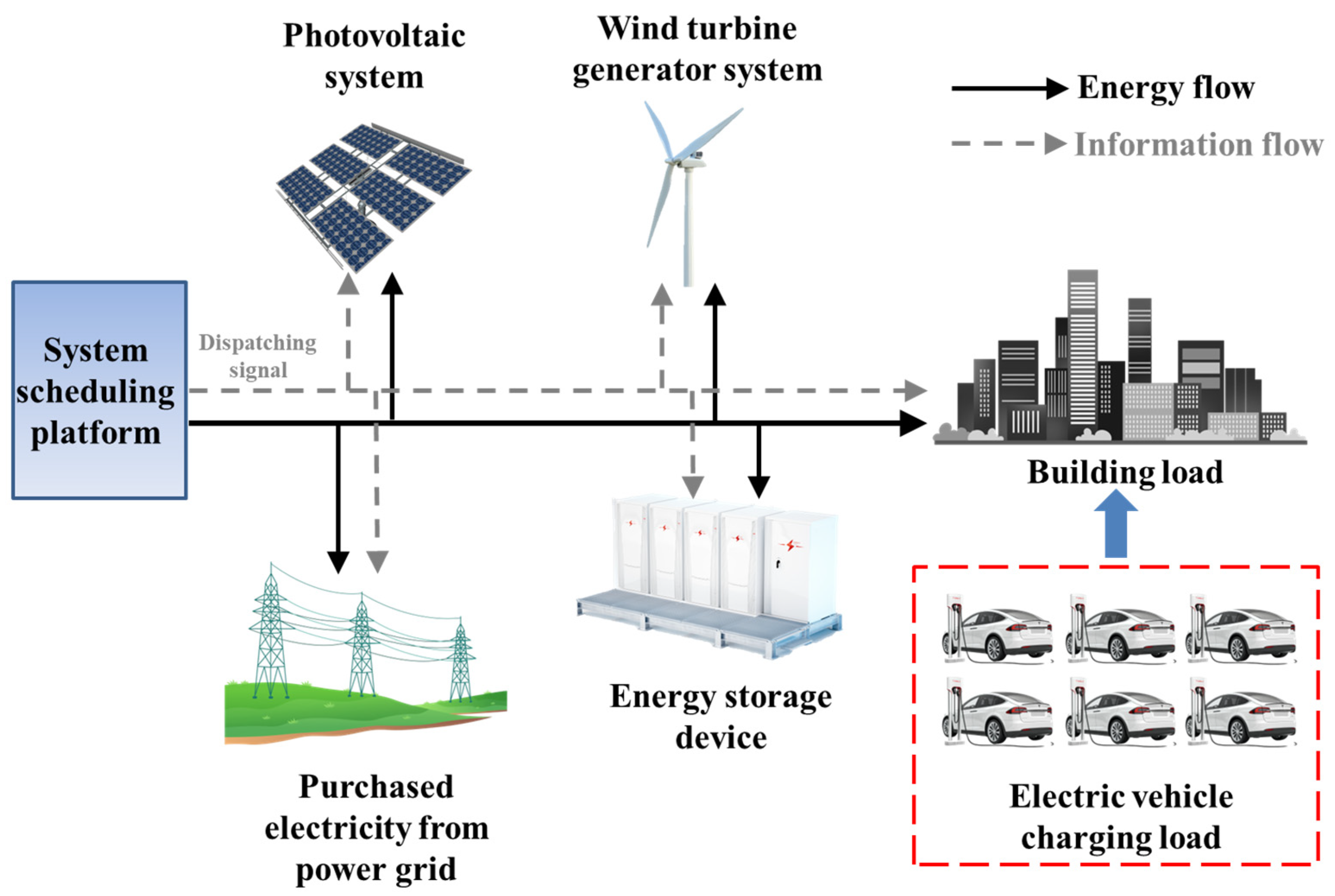

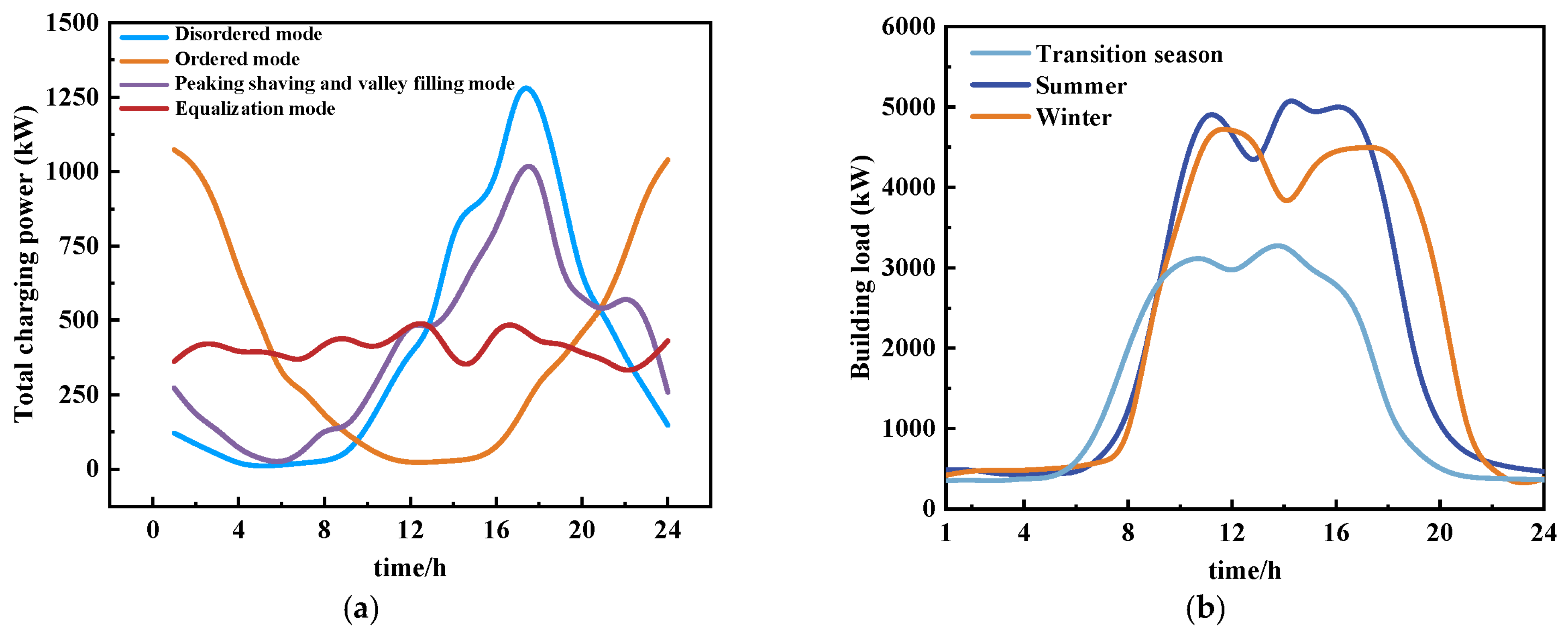
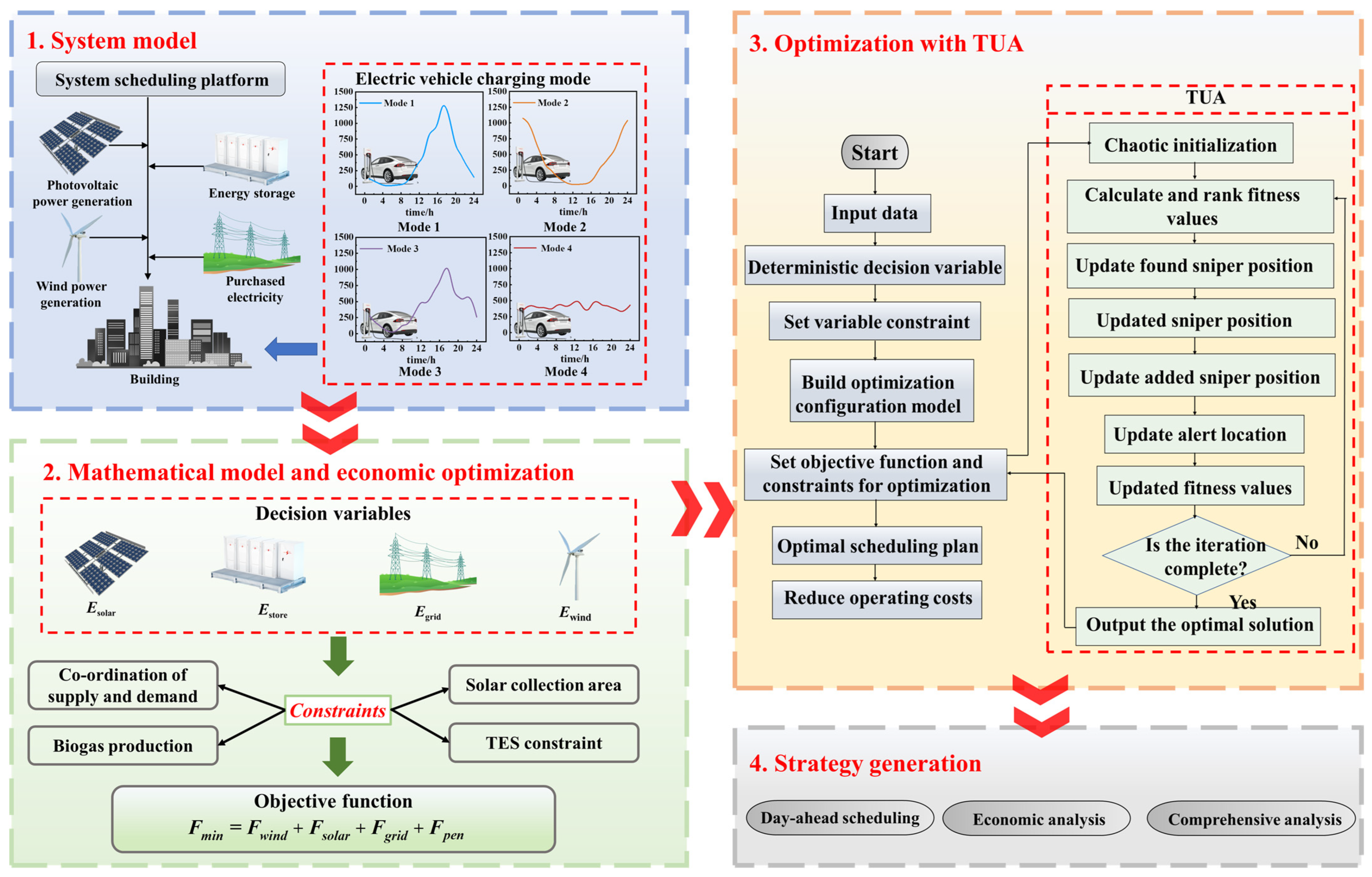
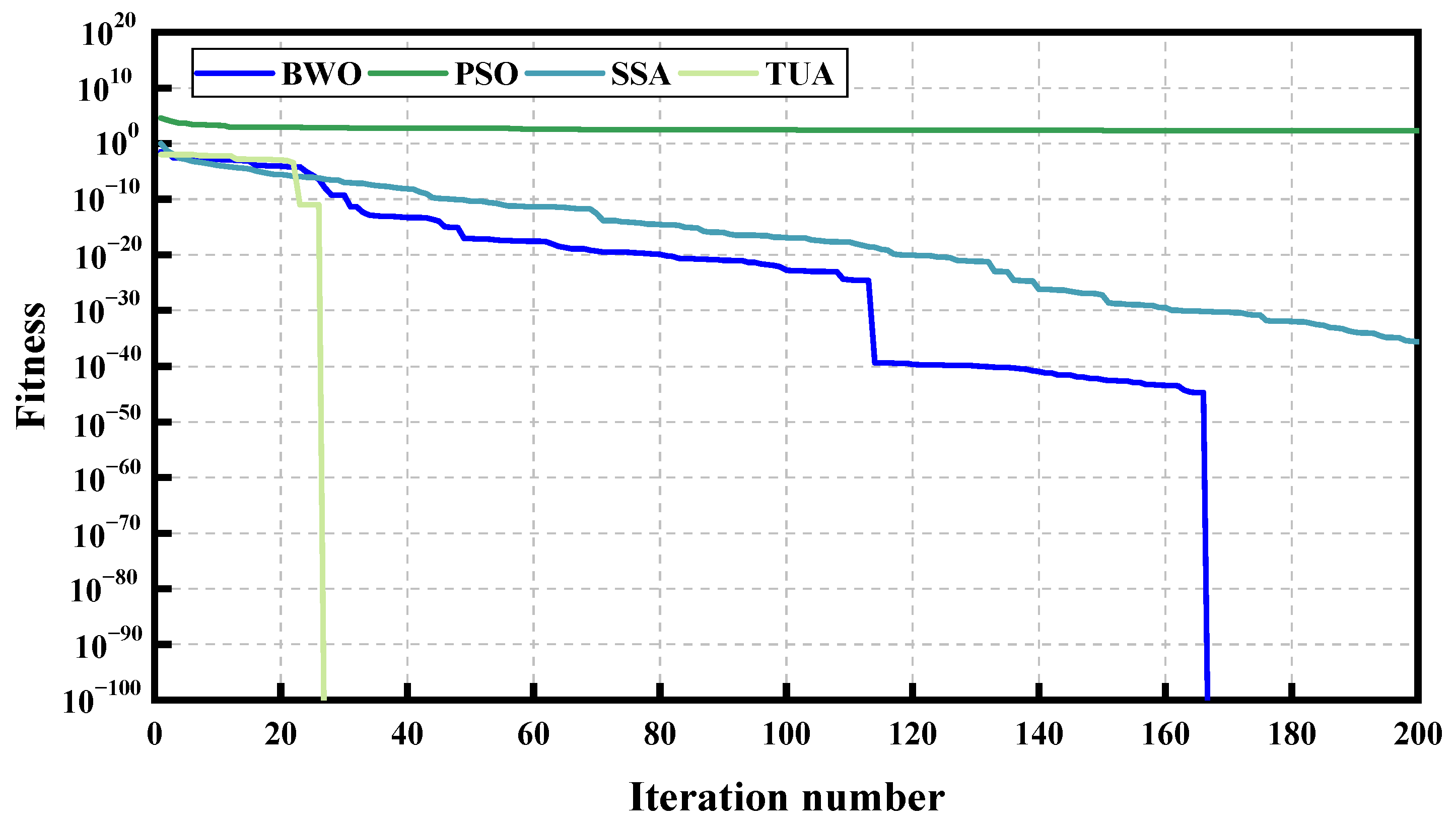
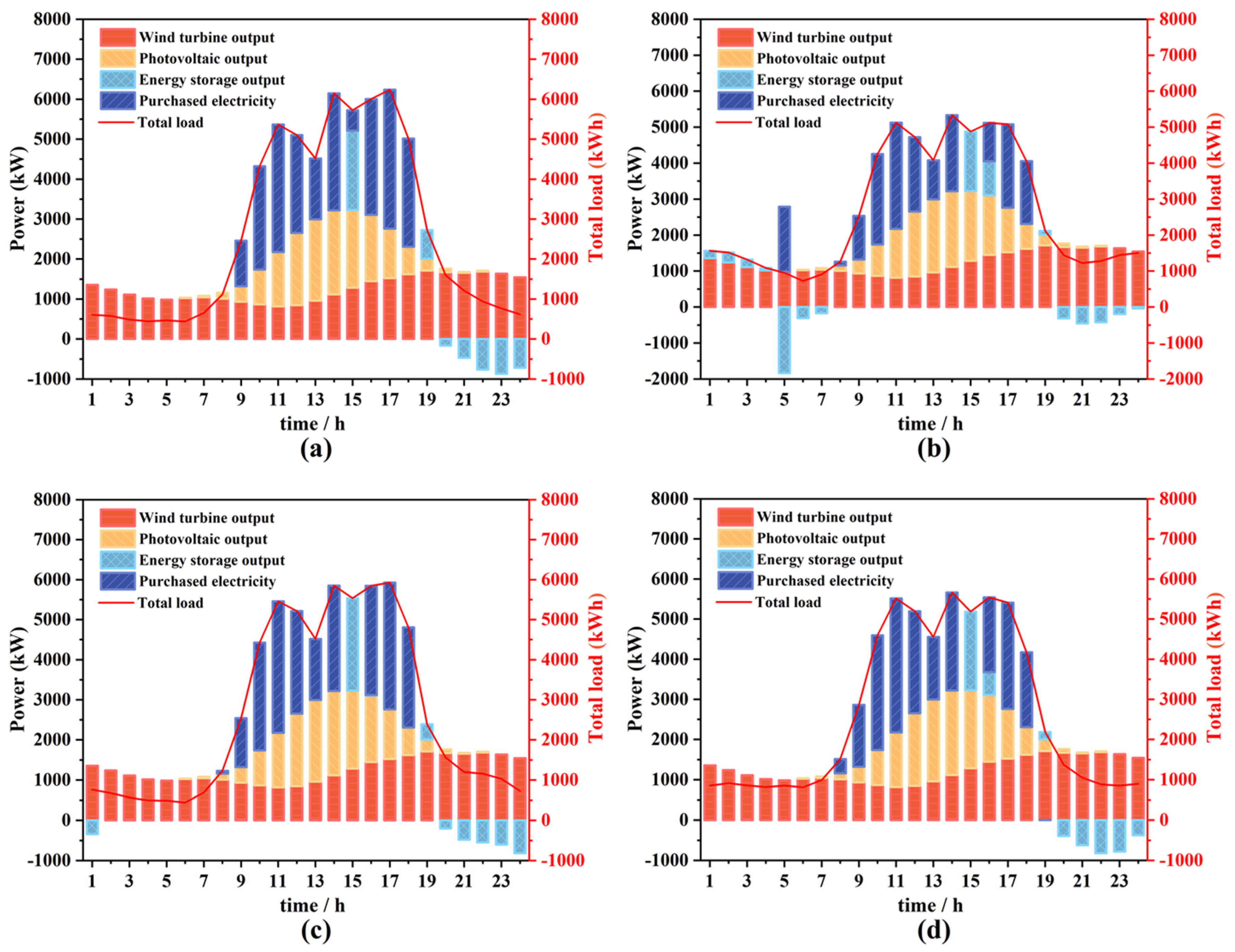
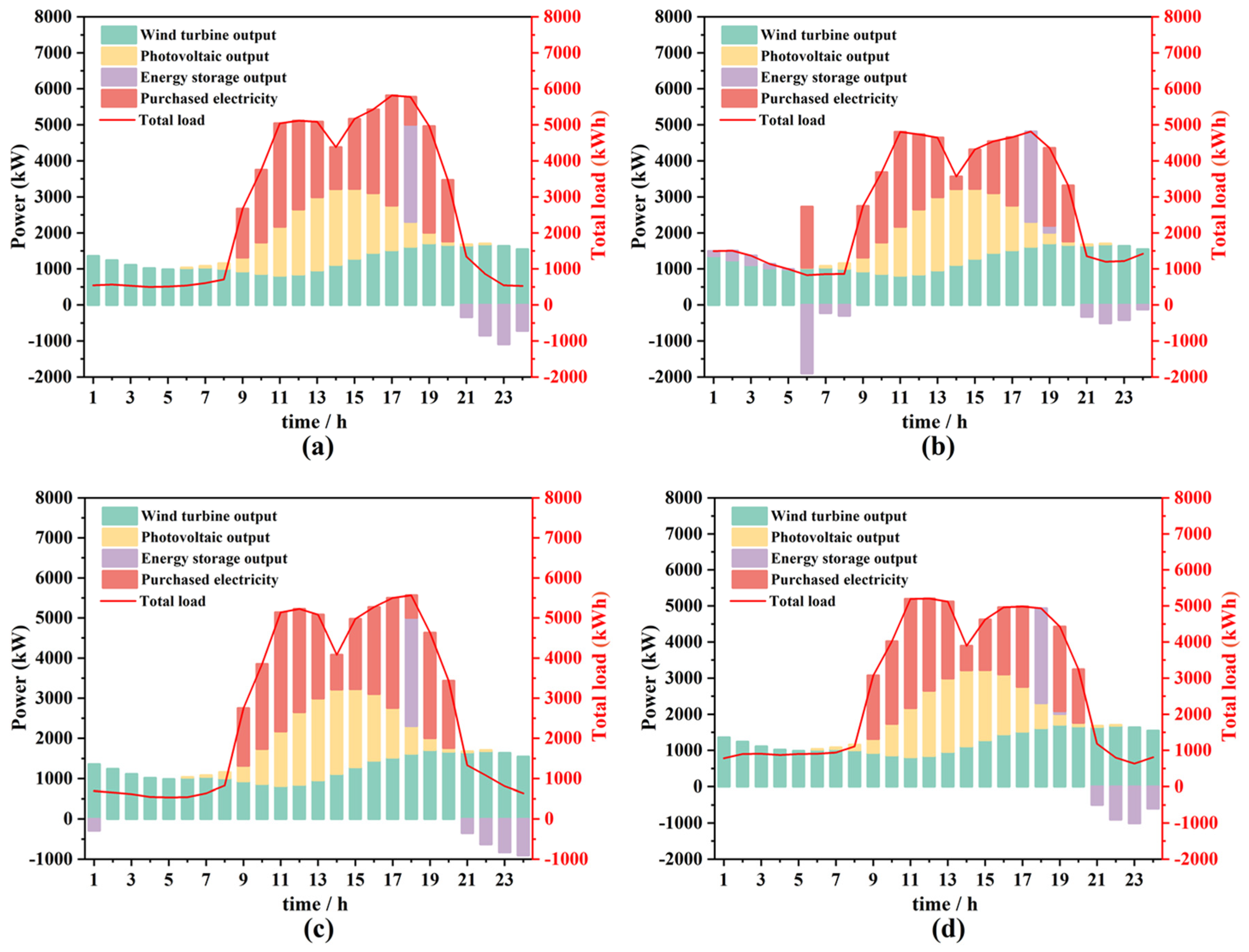
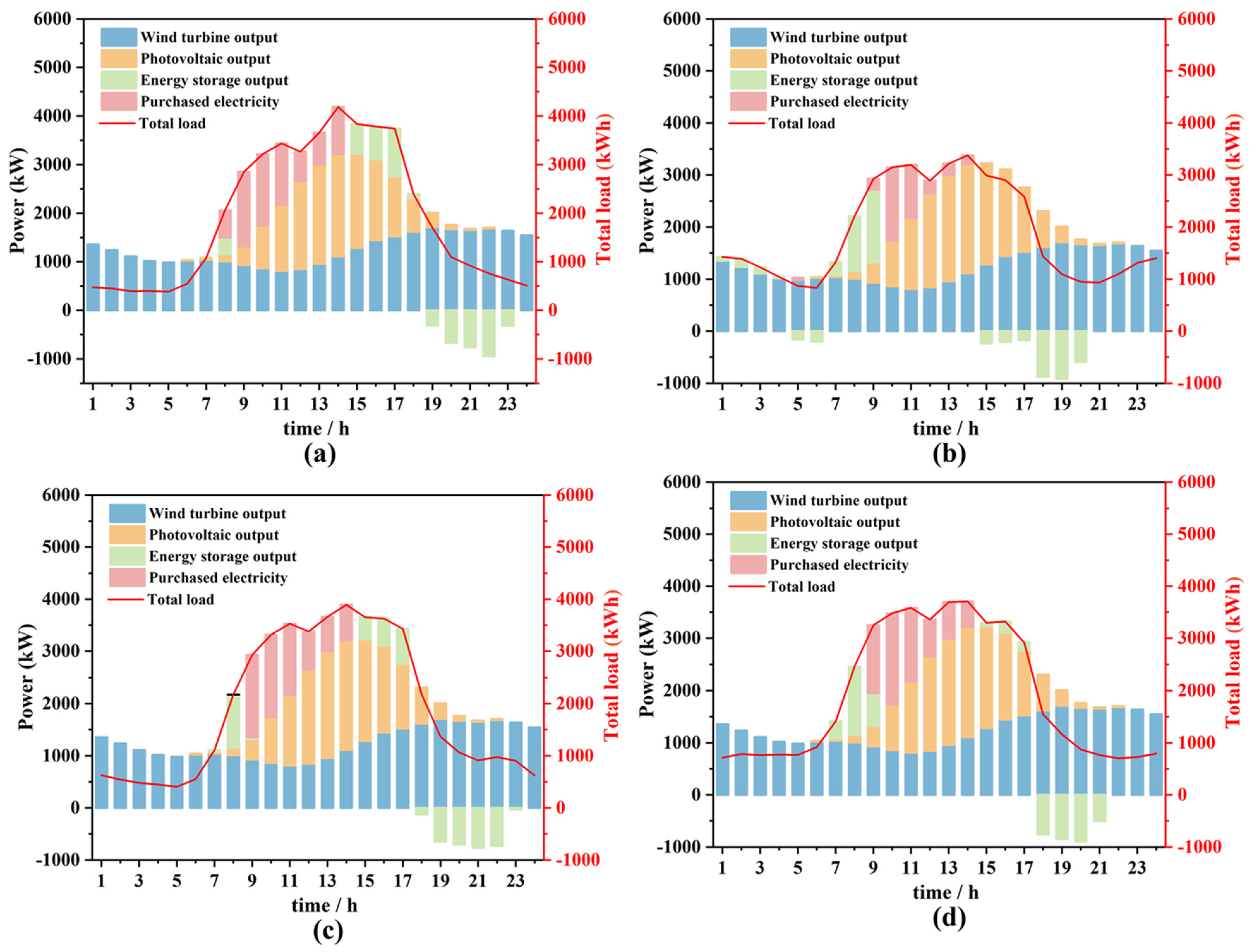
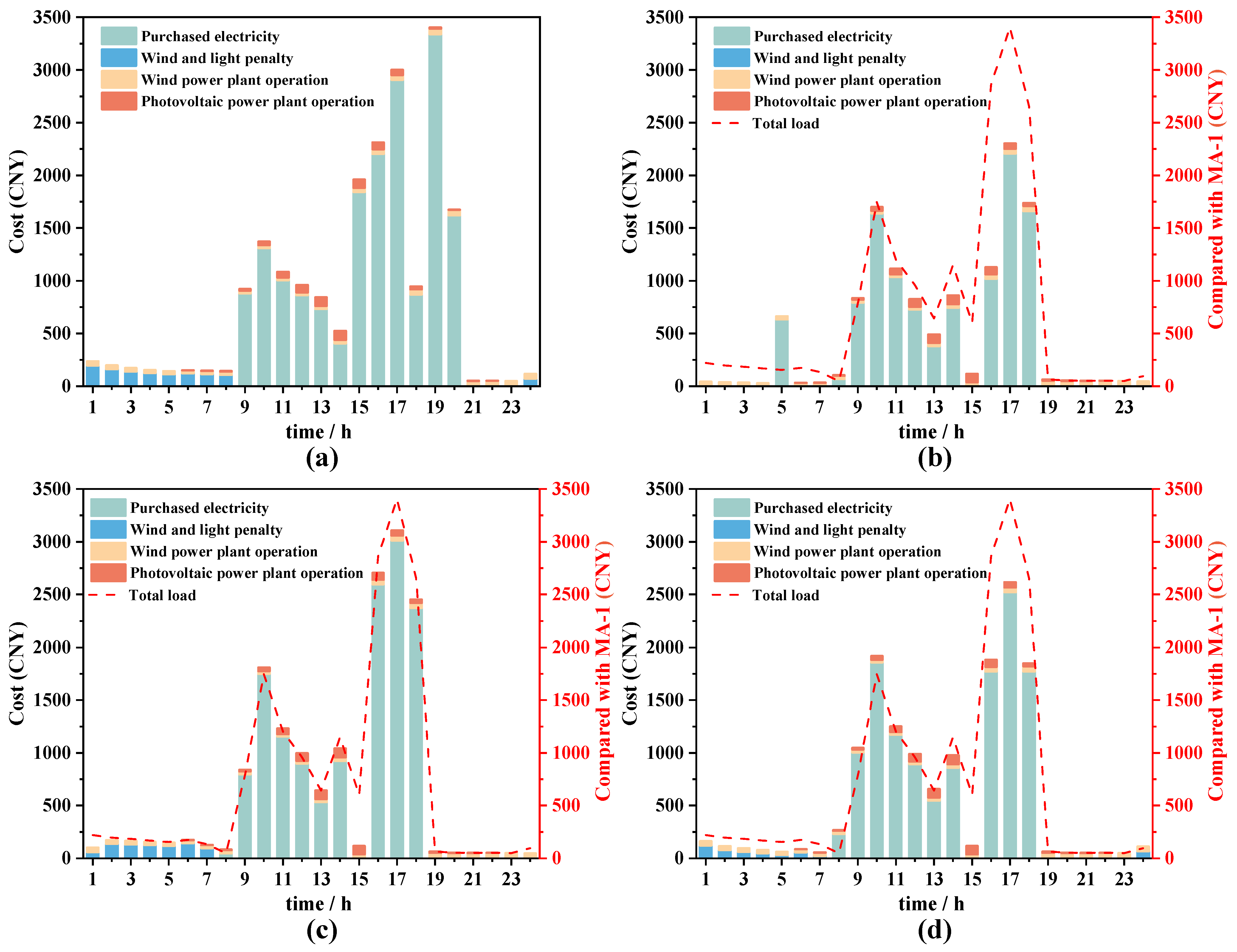
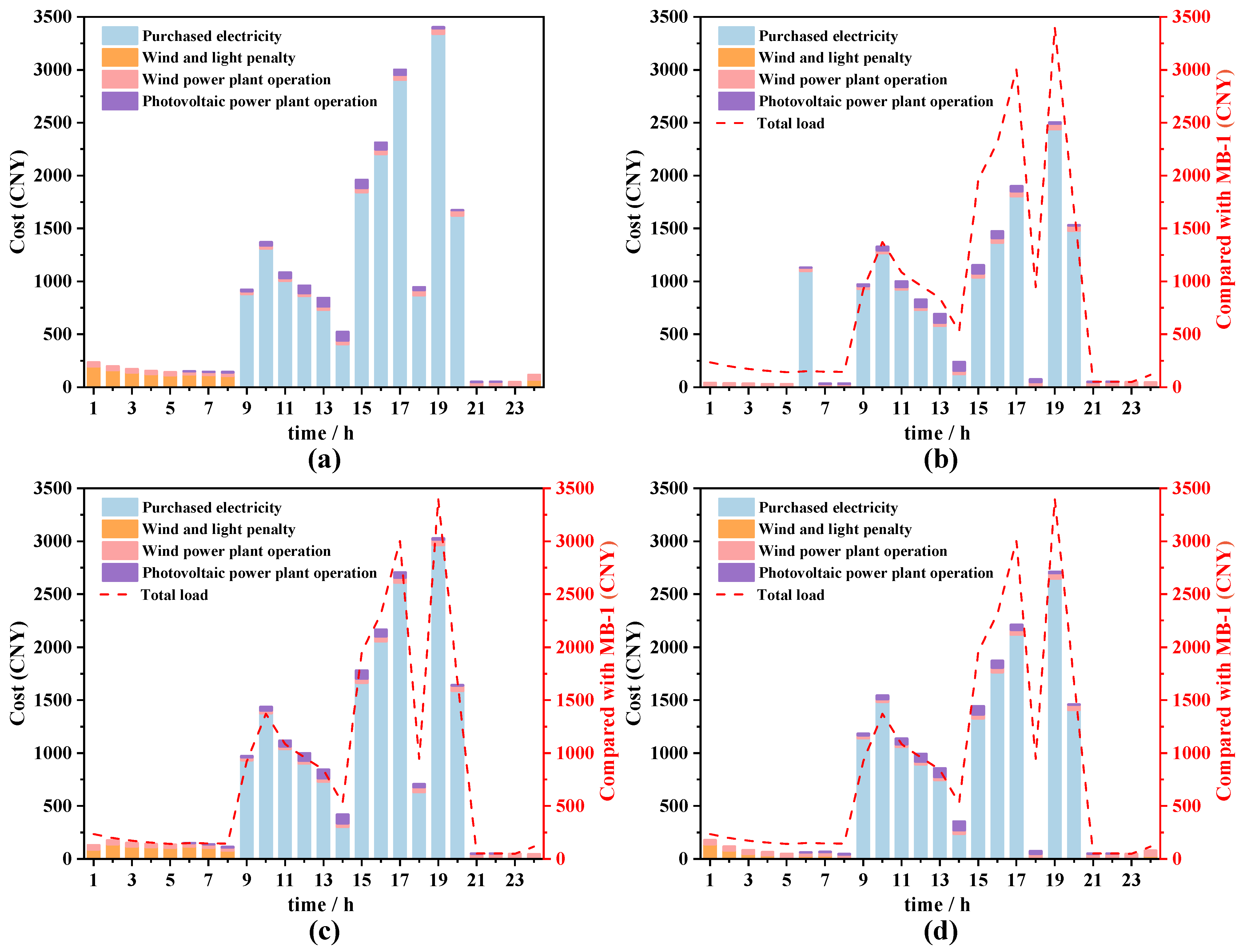


| Time Type | Specific Time Period | Electricity Price (CNY/kWh) |
|---|---|---|
| Time of trough | 11:00–15:00, 1:00–6:00 | 0.351 |
| Normal time period | 6:00–11:00, 23:00–1:00 | 0.651 |
| Peak hours | 15:00–23:00 | 0.951 |
| Summer peak hours | 19:00–21:00 | 1.131 |
| Winter peak hours | 18:00–20:00 | 1.131 |
Disclaimer/Publisher’s Note: The statements, opinions and data contained in all publications are solely those of the individual author(s) and contributor(s) and not of MDPI and/or the editor(s). MDPI and/or the editor(s) disclaim responsibility for any injury to people or property resulting from any ideas, methods, instructions or products referred to in the content. |
© 2025 by the authors. Licensee MDPI, Basel, Switzerland. This article is an open access article distributed under the terms and conditions of the Creative Commons Attribution (CC BY) license (https://creativecommons.org/licenses/by/4.0/).
Share and Cite
Li, G.; Wang, C.; Zheng, J.; Lu, Z.; Zhao, Z.; Cui, J.; Bi, S.; Gao, X.; Yang, X. Comprehensive Analysis and Optimization of Day-Ahead Scheduling: Influence of Wind Power Generation and Electric Vehicle Flexibility. Energies 2025, 18, 1639. https://doi.org/10.3390/en18071639
Li G, Wang C, Zheng J, Lu Z, Zhao Z, Cui J, Bi S, Gao X, Yang X. Comprehensive Analysis and Optimization of Day-Ahead Scheduling: Influence of Wind Power Generation and Electric Vehicle Flexibility. Energies. 2025; 18(7):1639. https://doi.org/10.3390/en18071639
Chicago/Turabian StyleLi, Guocheng, Cong Wang, Jian Zheng, Zeguang Lu, Zhongmei Zhao, Jinglan Cui, Shaocong Bi, Xinyu Gao, and Xiaohu Yang. 2025. "Comprehensive Analysis and Optimization of Day-Ahead Scheduling: Influence of Wind Power Generation and Electric Vehicle Flexibility" Energies 18, no. 7: 1639. https://doi.org/10.3390/en18071639
APA StyleLi, G., Wang, C., Zheng, J., Lu, Z., Zhao, Z., Cui, J., Bi, S., Gao, X., & Yang, X. (2025). Comprehensive Analysis and Optimization of Day-Ahead Scheduling: Influence of Wind Power Generation and Electric Vehicle Flexibility. Energies, 18(7), 1639. https://doi.org/10.3390/en18071639







